
The Victor-Victrola Page

Victrola Design Details
1. Cabinets
2. Cranks, Brakes and Speed Controls
4. Lid Supports, Record Albums and Needle Trays
Pictures and details on some of the design features of Internal Horn Victrola phonographs. Each sequential page covers one aspect of the evolving designs. Advance to the next page via the link above or at the bottom of each page
Design Details: Cranks, Brakes and Speed Controls
All Victrolas had a basic crank, a brake to stop the turntable, and a speed control to adjust the turntable speed
Cranks (Victor referred to these as "Winding Keys").
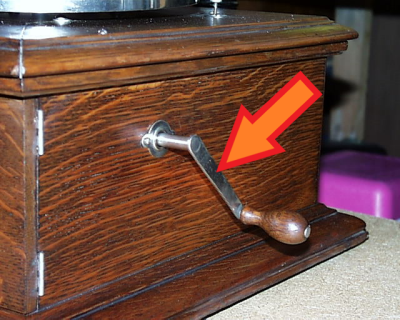 Early
Victrolas used Flat-Shank winding keys. Most of these cranks had
female threads. The thread sizes vary, depending on date of manufacture
Early
Victrolas used Flat-Shank winding keys. Most of these cranks had
female threads. The thread sizes vary, depending on date of manufacture
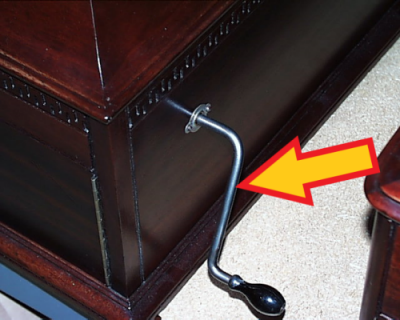 Later
Victrolas used Round-Shank winding keys. These cranks used either
a male or female thread, depending on date of manufacture. Thread sizes vary.
Later
Victrolas used Round-Shank winding keys. These cranks used either
a male or female thread, depending on date of manufacture. Thread sizes vary.
Brakes

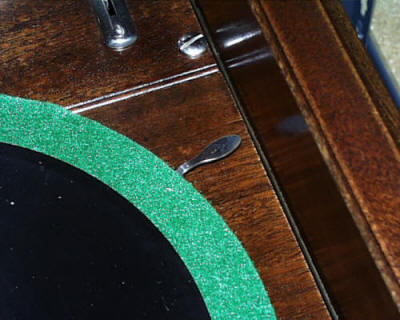
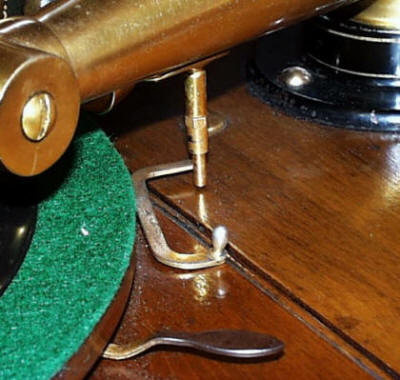 In 1913, Victor deployed a new
Semi-Automatic Brake design on premium models, which allowed the user to manually preset a
shutoff point at the end of the record by moving the yoke, so that the brake
would be engaged by the tonearm extension rod when the record had ended. This
feature became standard on most models (excepting the low-end machines) by the
early 1920's. It can be readily identified by the
adjustable brake yoke mechanism under the tonearm. The tab control (shown at bottom)
continued to be used with the semi-automatic brake system for manual control of
stop/start functions.
In 1913, Victor deployed a new
Semi-Automatic Brake design on premium models, which allowed the user to manually preset a
shutoff point at the end of the record by moving the yoke, so that the brake
would be engaged by the tonearm extension rod when the record had ended. This
feature became standard on most models (excepting the low-end machines) by the
early 1920's. It can be readily identified by the
adjustable brake yoke mechanism under the tonearm. The tab control (shown at bottom)
continued to be used with the semi-automatic brake system for manual control of
stop/start functions.
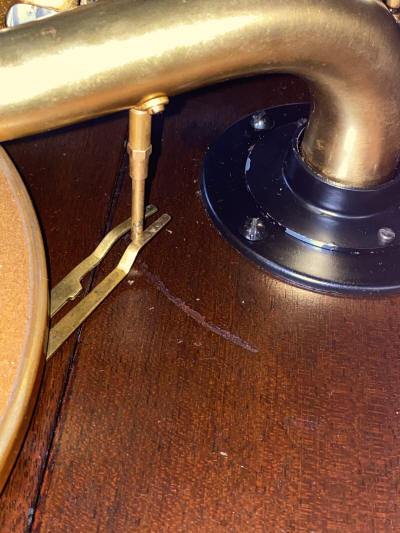 An advanced Fully Automatic Brake
system was introduced in late 1925 on some of the new Orthophonic Victrolas. This system required no user settings, relying on the eccentric groove
at the end of
the record to trigger the brake. Note the slotted brake actuator that
follows the tonearm extension rod and triggers the brake mechanism. The brake
tab control continued to be used for manual control of start/stop functions.
An advanced Fully Automatic Brake
system was introduced in late 1925 on some of the new Orthophonic Victrolas. This system required no user settings, relying on the eccentric groove
at the end of
the record to trigger the brake. Note the slotted brake actuator that
follows the tonearm extension rod and triggers the brake mechanism. The brake
tab control continued to be used for manual control of start/stop functions.
SPEED CONTROLS
All Victors had some type of control on the motorboard to vary the motor speed to match the record being played. Early record manufacturers would record at speeds varying from 60 to 90 RPM. All Victor records are intended to be played at 78 RPM

The
lowest-priced Victrola models (such as the "VV-IV" and "VV-VI") used a Simple Speed Control
Knob to adjust the turntable speed (left). Many years later (in the
late 1920's) many Orthophonic models reverted to this basic design.
Around
1912 some of the lower-priced machines used a Semi-Circular
Speed Control Bezel design for a few years.
 In late 1913, some of
the premium models such as the "VV-XIV" and "VV-XVI" began
using the Exposed Speed Indicator, which was
the predecessor to the glass-covered speed dial that was in-use for many years.
This speed control system permitted the user to monitor the actual turntable speed as it was being
adjusted (using the control knob), making adjustments much easier. The Exposed
Indicator had no protection for the fragile indicator needle, making damage quite
easy. In addition, it tended to get bumped out of calibration. It was replaced with the Large Glass Indicator (below) very shortly after
introduction, and many machines that originally came with the Exposed Speed
Indicator were retrofitted with the newer control.
In late 1913, some of
the premium models such as the "VV-XIV" and "VV-XVI" began
using the Exposed Speed Indicator, which was
the predecessor to the glass-covered speed dial that was in-use for many years.
This speed control system permitted the user to monitor the actual turntable speed as it was being
adjusted (using the control knob), making adjustments much easier. The Exposed
Indicator had no protection for the fragile indicator needle, making damage quite
easy. In addition, it tended to get bumped out of calibration. It was replaced with the Large Glass Indicator (below) very shortly after
introduction, and many machines that originally came with the Exposed Speed
Indicator were retrofitted with the newer control.
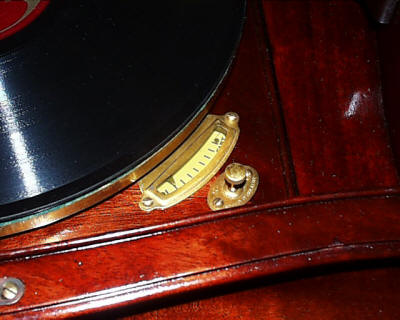
The
speed control design was simplified in 1916. The Small Glass Speed Control
used the same principal as the Large Glass version, but integrated the two
bezels into one assembly, and reduced the size of the dial indicator. This
configuration was used on many models up through the late 1920's.
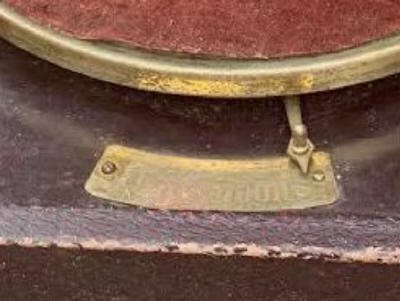 Some
portable "suitcase" models use a simple pointer-adjustment to control
turntable speed.
Some
portable "suitcase" models use a simple pointer-adjustment to control
turntable speed.

